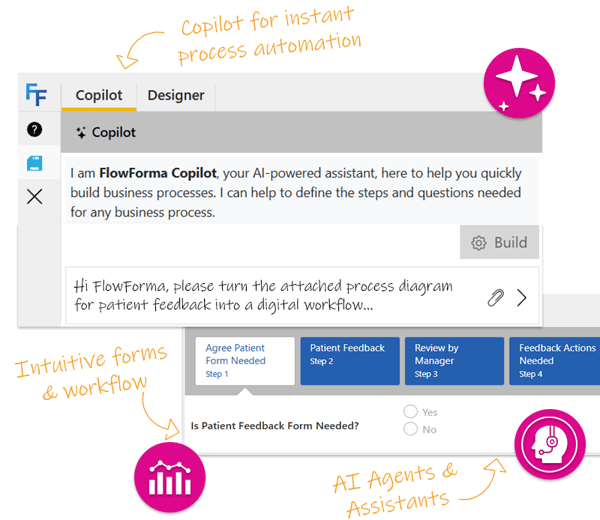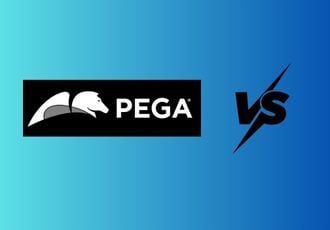Every organisation depends on processes to function — from approving invoices to onboarding employees or conducting safety checks. Yet many of these business processes are still handled through spreadsheets, emails, or paper forms. The result is inefficiency, errors, and compliance risks that slow progress and frustrate staff.
A Business Process Management (BPM) workflow provides the structure to fix this. By mapping steps, assigning responsibility, and applying workflow automation, organisations can streamline operations, improve efficiency, and achieve business objectives with greater confidence.
In this article, we’ll define what a BPM workflow is, explain how it differs from BPM, explore its benefits and challenges, share examples across industries, and highlight why FlowForma is a leading BPM workflow software.
What is a BPM Workflow?
A Business Process Management (BPM) workflow is a type of workflow designed to manage and optimise business processes.
It involves using software tools and methodologies to design, implement, and monitor these processes in a structured way. The goal is to improve operational efficiency, reduce costs, and enhance customer satisfaction.

The workings of a BPM workflow
BPM workflow is a core aspect of BPM itself. It provides the operational framework for executing business strategy, ensuring routine tasks are completed consistently and aligned with broader business objectives.
Suggested read: Business process automation.
Is a BPM Workflow the Same as BPM?
Although the two terms are closely related, a BPM workflow is not the same thing as Business Process Management (BPM). BPM is the broader discipline — it focuses on analysing, improving, and governing processes across the entire organisation to align them with business strategy and long-term objectives.
 The workings of BPM
The workings of BPM
A BPM workflow, on the other hand, is the operational execution of a single process. It defines the sequence of tasks, who performs them, and the rules that guide their completion.
Put simply, BPM sets the strategic framework for continuous improvement, while BPM workflows bring that framework to life in day-to-day operations. Both are essential: without BPM, workflows lack strategic alignment; without workflows, BPM remains theoretical.
For example, a university may adopt BPM as a strategy to improve student administration. Within that programme, a BPM workflow could automate the student registration process, routing applications through checks, approvals, and confirmations.
|
Aspect |
BPM Workflow |
BPM |
|
Scope |
One process (e.g., student registration) |
Entire organisation (e.g., all academic and administrative processes) |
|
Focus |
Task execution and process design |
Business strategy and continuous improvement |
|
Purpose |
Ensure tasks are completed consistently and efficiently |
Align all processes with organisational goals |
|
Example |
Approving a purchase order |
Redesigning the full procurement function |
Understanding this distinction is essential when evaluating BPM vs workflow. BPM provides the overarching strategy and continuous improvement model, while workflows provide the structured execution needed to bring that strategy to life.
BPM and Workflows: How They Work Together
 BPM and workflows working together
BPM and workflows working together
BPM and workflows are complementary. BPM sets the map — identifying areas for optimisation and aligning processes with business strategy. Workflows are the journey — the step-by-step flows that deliver tangible results.
When combined, they:
- Standardise business activities across departments.
- Capture structured data for better reporting.
- Provide visibility into bottlenecks and risks.
- Support continuous improvement by linking strategy to process execution.
Modern BPM workflow management software integrates both layers. For example, FlowForma combines workflow design, forms, analytics, and document generation in one platform. This avoids the complexity of stitching together separate BPM tools and reduces reliance on IT, empowering business users themselves to digitise and optimise processes.
Benefits of Business Process Management Workflows

BPM workflow benefits
BPM workflows offer multiple benefits that enhance efficiency, reduce costs, improve compliance, and foster collaboration.
1. Faster process execution
Manual processes delay progress because they rely on people sending reminders or moving paper forms. Automated workflows route tasks instantly, keep processes moving, and trigger escalations when approvals are overdue.
Case Study in Focus: Morley College London
Learn how Morley College London, have deployed FlowForma's business process management platform to drive operational excellence in their institution.
Morley College London was struggling with slow, manual, and error-prone processes using legacy systems, such as InfoPath and Nintex, which created significant delays and increased administrative overhead.
By adopting FlowForma Process Automation, the college was able to empower staff to design and manage workflows independently, eliminating the need for IT support.
FlowForma’s no-code platform automates key processes, including admissions, curriculum management, and HR workflows. This transformation not only boosted operational efficiency but also laid the foundation for ongoing process improvements and digital innovation across the college.
.jpg?width=600&height=400&name=Wills%20Quote%20(600%20x%20400%20px).jpg) Client testimonial for FlowForma
Client testimonial for FlowForma
2. Reduced operational costs
Administrative tasks such as data entry, chasing approvals, and generating reports consume valuable staff hours. By automating routine tasks, BPM workflows reduce these overheads, allowing employees to focus on higher-value work.
For instance, Bouygues Energies reported building workflows up to five times faster with FlowForma compared to Power Automate (formerly Power Apps). Faster deployment meant reduced project costs, quicker time to value, and lower reliance on IT developers.
3. Stronger compliance and governance
With tools like FlowForma, every step in a BPM workflow is time-stamped, logged and auditable.
This reduces the risk of incomplete documentation or missed approvals, making it easier to meet compliance obligations (such as DORA for financial services or GDPR for healthcare).
 FlowForma’s compliance features
FlowForma’s compliance features
4. Transparency and accountability
Workflows provide a shared view of process progress. Employees are aware of their responsibilities, managers can identify bottlenecks, and auditors have access to complete records without requiring manual preparation.
5. Collaboration across teams
 Collaborate seamlessly across teams with tools like FlowForma
Collaborate seamlessly across teams with tools like FlowForma
Because processes often span multiple departments, BPM workflows enable HR, finance, IT, operations, and fusion teams — cross-functional groups of business and IT users — to collaborate within a single, structured flow.
This reduces silos and ensures both technical and business perspectives are incorporated into workflow design.
Examples of BPM Workflows
BPM workflows are versatile tools that can optimise operations across various industries. Here are a few examples of how they’re transforming business processes in key sectors:
1. Finance
In finance, BPM workflows ensure compliance, streamline approvals, and eliminate manual errors.
- Procure-to-Pay: Automates procurement requests, budget checks, approvals, and vendor payments, ensuring timely transactions and regulatory compliance.
- Expense Approvals: By digitising the approval process, Abingdon & Witney College saved 402 hours annually, allowing the finance team to focus on strategic financial planning instead of manual data entry.
- Contract Management: FlowForma automates the tracking of contract sign-offs, renewals, and compliance documentation. At Vestergaard, this workflow digitised the entire contract lifecycle, reducing delays, improving visibility for all stakeholders, and ensuring compliance, while storing contracts centrally for auditability.
2. Healthcare
In healthcare, where patient safety and compliance are paramount, BPM workflows provide clear accountability and real-time monitoring.
- Claims Management: Tools like FlowForma automate insurance claims submission and processing, reducing manual errors and expediting reimbursements.
 Claims Process Creation using AI Copilot
Claims Process Creation using AI Copilot
- Patient Referrals: NHS trusts have utilised FlowForma to securely and instantly transfer patient data, thereby improving the speed and accuracy of referrals and enhancing the patient experience.
- Audit Reporting: Automated logs simplify compliance with GDPR and HIPAA, ensuring healthcare organisations meet stringent regulatory requirements with less effort.
3. Construction
Construction projects are complex, involving multiple stakeholders and strict safety regulations. BPM workflows bring clarity and efficiency to these multifaceted tasks.
- Site Inspections: Digitising safety checklists ensures compliance with health and safety standards, reducing risks and improving operational efficiency on-site. At PJ Hegarty, the Safety Behavior Observation (SBO) process was paper-based initially. FlowForma replaced this with a mobile, QR code–based workflow, enabling quick on-site observations and real-time insight across all projects.
- Permit Requests: Automating permit approvals and tracking conditions helps prevent project delays and ensures all legal requirements are met before work begins.
- Field Reporting: Downer replaced several legacy processes with streamlined AI-powered workflows using FlowForma, including its field reporting process. This enhanced communication and reduced delays in reporting.
Downer case study: Complete Webinar
4. Human Resources
HR departments are highly people-centric but often burdened by paperwork. BPM workflows simplify administrative tasks, improving efficiency and employee experience.
- Recruitment and Onboarding: FlowForma automates every stage of the employee journey, from job posting to contract generation and onboarding, creating a smoother experience for both candidates and HR teams.
Build onboarding process with FlowForma
- Performance Appraisals: Automated reminders and process tracking ensure consistent performance evaluations across departments, improving employee development and satisfaction.
- Leave Requests: Digital workflows guarantee that leave requests are approved quickly, while also maintaining an accurate record of employee time off for HR teams.
5. Education
Educational institutions often face complex, time-sensitive administrative processes. BPM workflows help streamline operations, reduce delays, and improve transparency.
- Student Registration: Automates the enrolment and approval process, reducing administrative burden and improving the student experience during registration periods.
- Curriculum Management: Tracks submissions and approvals for course materials, ensuring all documentation is up-to-date and easily accessible for faculty and administration.
- Grant Applications: Streamlines the submission, review, and approval process for grants, providing transparency for both applicants and grant managers.
 Try the FlowForma playground to automate key workflows in the education sector.
Try the FlowForma playground to automate key workflows in the education sector.
Suggested read: Education Workflow Automation
Common Challenges Faced With Traditional BPM Software
 Challenges faced with traditional business process management tools
Challenges faced with traditional business process management tools
Despite their advantages, traditional BPM approaches can create new problems:
- Dependence on developers: Many BPM solutions require coding, leaving business users dependent on IT and slowing project delivery. Besides, hiring developers to build and maintain workflows can be costly and time-consuming.
- Hidden costs: Vendors that charge per user create budgeting challenges.
- Complex processes: Legacy platforms often struggle when multiple workflows run at once.
- Limited compliance features: Without robust audit trails, regulatory reporting becomes risky and time-consuming.
FlowForma addresses these issues by providing business users with a no-code platform that features AI capabilities, seamlessly embedding compliance and audit trails into every process.
How FlowForma stands apart from traditional BPM tools
FlowForma is an AI-powered business process automation software designed to help organisations quickly, securely, and efficiently digitise and scale their workflows, without hidden costs.
1. No-code workflow design
FlowForma empowers business users to design and modify workflows, while still providing IT teams with the reassurance that processes are being developed in a controlled environment.
By enabling business users to act as citizen developers, FlowForma reduces dependency on IT, lowers costs, accelerates deployment, and allows organisations to respond quickly to changing business needs.
 FlowForma’s no-code process automation tool
FlowForma’s no-code process automation tool
2. All-in-one platform
FlowForma integrates workflow automation, forms, document generation, and analytics into a single solution:
Workflow automation: Automate task routing, approval flows, escalations, delegation rules, notifications, branching logic, condition checks, and exception handling.
 Benefits of workflow automation
Benefits of workflow automation
Smart digital forms: Customisable, mobile-friendly forms with validation rules, conditional visibility, dynamic data fields, and auto-population of fields from other systems.
Document generation: Automatically produce documents (e.g., contracts, certificates, letters) by merging form data into templates.
Insights & analytics: Built-in dashboards and reporting to monitor performance metrics, identify bottlenecks, and surface process trends.
4. AI-powered features
 AI Features
AI Features
FlowForma’s AI suite is rich and multifaceted. It includes several intelligent components that work together to accelerate process automation, data extraction, decision-making, and clarity. These include:
- AI Copilot: Lets users describe processes in natural language (or upload forms/diagrams). The Copilot then builds a draft workflow skeleton — including steps, logic, branching, and form fields. Watch this video to learn more.
- Discovery Agent: Ambient process capture from meetings, voice, or conversations. It translates spoken discussion or whiteboard sessions into ready-to-review workflows, reducing the need for workshops or manual documentation.
- AI Agent Rules: Intelligent rules embedded in workflows that can read uploaded documents, extract structured data, validate and format data, and push results back into forms or downstream systems.
- Smart Assistants: In-the-flow helpers for both process builders and end users. For builders, they can suggest next steps (“Auto-suggest this rule”), remind them of missing logic, or generate to-do checklists. For users, assistants can interpret natural language instructions (e.g., “I want to submit a reimbursement”) and guide form-filling or workflow initiation.
- Summarisation: At any stage of a process, you can trigger a summarisation agent that generates a natural-language synopsis of what’s happened so far — including key decisions, blockers, anomalies, and essential data. Useful for audits, handovers, or stakeholder updates.
- Agentic AI (Actioning Agents): These agents don’t just observe — they can act. They can trigger actions autonomously within a workflow (e.g., escalate, pause, reroute, send notifications) based on defined conditions or triggers.
Caption: Learn about FlowForma’s AI features in the masterclass
5. Transparent pricing
FlowForma offers a process-based pricing model that enables organisations to scale their automation efforts confidently without hidden costs. All plans are based on a 12-month contract billed annually, providing businesses with a predictable cost structure and flexibility as they scale their automation efforts.
6. Data security
FlowForma works within the Microsoft 365 system, with all data stored securely in the client’s own SharePoint Online tenancy. This ensures organisations retain full ownership of their information while inheriting Microsoft’s enterprise-grade security, encryption, and compliance controls.
Because it runs inside your tenant, FlowForma respects existing governance policies such as data loss prevention, retention, and backup.
Unlock Greater Efficiency and Compliance with BPM Workflows
BPM workflows powered by FlowForma are a game-changer for organisations seeking to streamline business operations, enhance efficiency, and ensure compliance across various industries.
By automating manual processes, reducing errors, and enhancing visibility, businesses can achieve significant time and cost savings while driving continuous process improvement.
Start your free trial today to learn more!
.png) By
By 




